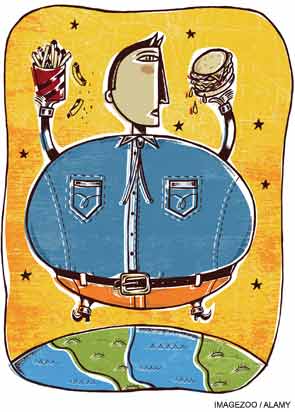

Govern well thy appetite, lest sin surprise thee, and her black attendant Death.
—John Milton, Paradise Lost (1667)
To lengthen thy life, lessen thy meals.
—Benjamin Franklin, Poor Richard’s Almanack (1737)
Every four months, I set aside a special time for one of my patients whose visits create a logistical nightmare. Hobbled by a pair of osteoarthritic knees and a body mass index (BMI) well into the upper fifties, Molly barely walks. Not happily, she moved to an assisted living facility at a relatively young age. Her daughter is left with the unenviable task of coordinating her outings. First, she needs to book time off work so that she can accompany her mom to the clinic. Then she reserves a specialized transit car equipped with an oversized wheelchair ramp for the ride to the clinic. When she arrives, we stack my office chairs and shove my desk into a corner. Since Molly and her wheelchair don’t fit easily through the door, she often ends up sitting half in and half out of my office. Scheduling Molly as my last appointment of the day provides her with some faint measure of privacy.
I can’t blame the architects who designed our clinic space 25 years ago for failing to realize that one day, there would be a need for wider doorways that could accommodate wheelchairs ferrying patients who weigh more than 400 pounds. There is a host of other shortsighted design elements in hospitals built in that era. Exam tables are often too narrow, blood pressure cuffs too tight, scales too fragile, ambulance stretchers too flimsy, and imaging equipment too cramped to handle our obese patients (defined as adults having a BMI above 30). Literally, some patients are just too large to fit into our cramped hospital environs. When did this size transformation occur?
Fads, Fat, and Fashion
Actually, the worldwide obesity epidemic is a relatively recent phenomenon. Though many observers consider its onset to be in the early 20th century when the industrialization and modernization of many countries took hold, obesity rates in the United States did not immediately rise. In fact, just the opposite occurred. According to William Rothstein, PhD, professor of sociology at the University of Maryland in Baltimore, a revolution in women’s fashions about 1910 emphasized the “natural figure” and made the slender young woman rather than the full-figured mature body the sought-after model for fashion.1 The recently designed safety razor encouraged men to shave their beards, and newly exposed double chins were viewed with embarrassment. The wildly popular motion pictures popularized these fashion transformations by depicting willowy women and lanky men. With newer forms of transportation including trucks and railroads, fresh food became more readily available on a year-round basis. Food canning techniques and commercial refrigeration helped to extend the shelf life of fruits and vegetables.


